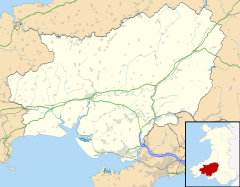Kidwelly
Kidwelly
|
|
|---|---|
 |
|
| Kidwelly shown within Carmarthenshire | |
| Population | 3,523 (ward 2011) |
| OS grid reference | SN407067 |
| Community |
|
| Principal area | |
| Ceremonial county | |
| Country | Wales |
| Sovereign state | United Kingdom |
| Post town | KIDWELLY |
| Postcode district | SA17 |
| Dialling code | 01554 |
| Police | Dyfed-Powys |
| Fire | Mid and West Wales |
| Ambulance | Welsh |
| EU Parliament | Wales |
| UK Parliament | |
| Welsh Assembly | |
| Website | kidwelly.gov.uk |
Kidwelly (Welsh: Cydweli) is a town and community in Carmarthenshire, west Wales, approximately 7 miles (11 km) north-west of the most populous town in the county, Llanelli. In the 2001 census the community of Kidwelly returned a population of 3,289, increasing to 3,523 at the 2011 Census.
It lies on the River Gwendraeth above Carmarthen Bay.
The earliest written form of the name, 'Cetgueli', is recorded by the monk, Nennius, writing in the 9th century. One theory is that the name means the land, territory, or kingdom of Cadwal. Another theory is that the name is the combination of the two words 'Cyd' (joint) and 'Gweli' (bed), i.e., the joining of the two river beds Gwendraeth Fawr and Gwendraeth Fach, wherein Cydweli lies. The town itself is ancient, established by written records at around 1106 AD.
The substantial and well preserved castle and church were established by the invading Normans in 1106. The earliest castle on the site was a typical Norman motte and bailey design that was made of earth and timber. The 13th century re-design was commissioned by Edward I Longshanks as a strategic part of his 'Ring of Steel' oppression against the Welsh. At the time of the stone castle's creation, Kidwelly benefited from the latest strategic military thinking in castle design. It had a concentric design with one circuit of defensive walls set within another to allow the castle to be held even if the outer wall should fall. The great gatehouse was begun late in the 14th century but it wasn’t completed until 1422, somewhat due to the Welsh rebel Owain Glyn Dŵr’s efforts to reclaim Welsh independence.
...
Wikipedia

